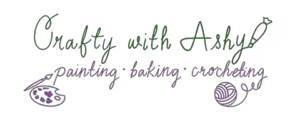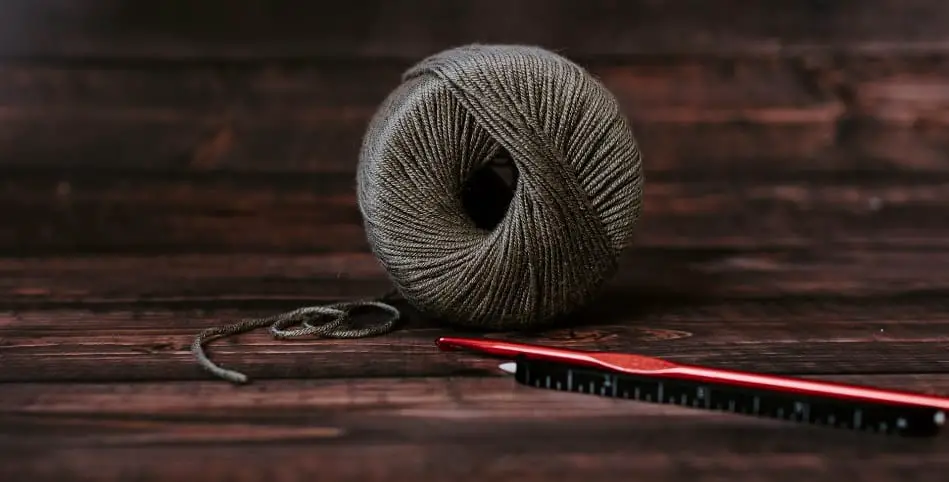Crocheting begins with two ingredients: a hook and yarn. There are a wide variety of both of these materials. If you are picking up crochet as a hobby, you will want to have some information before the, hopefully, long-term investment you make in your crochet hooks.
I recommend that beginners use a size I/9 (5.5 mm) crochet hook. Start with an aluminum hook like Susan Bates Silvalume Crochet Hook. It is inexpensive, but high quality. If you are prone to wrist/hand pain, you may want to invest in an ergonomic hook (the head and shaft are still aluminum), in which case I recommend the Clover Amour Crochet Hook. These are again high quality, but will cost more than a “normal” hook.
Crochet hooks come in a surprisingly wide variety of sizes, styles, and materials. Read further to really understand that variety available, the pros and cons of each, and tips for choosing the best ones! I will also provide some free crochet patterns using the Size I/9 (5.5 mm) hook that would be perfect for a beginner to work from!
Crochet Hook Sizes
Crochet hooks come in a multitude of sizes. Each pattern will have a hook size that it calls for. You will also see a hook size recommendation on the yarn packaging.
The smallest crochet hooks are called steel hooks. These are made to crochet thread to make delicate lace projects. They are made from steel because they are so thin and delicate that they would bend if they were made from other materials.
Steel crochet hooks range in size from 0.6 mm to 2.2 mm. These are more challenging to work with because they are tiny and harder to hold. The thread is also very thin which makes the stitches harder to see. I definitely recommend waiting until you have some experience with the basic crochet stitches before trying out these.
Regular crochet hooks range in size from 2.25 mm to 30 mm. In US sizing this is B to T/X sizes. These are used to crochet any size of yarn from thin “lace weight” and thick “Jumbo” yarns. Below is a chart with the US and Metric sizes listed for all of the regular size crochet hooks.
Crochet Hook Size Chart
| US | Metric |
|---|---|
| B-1 | 2.25 mm |
| 2.50 mm | |
| C-2 | 2.75 mm |
| D-3 | 3.25 mm |
| E-4 | 3.50 mm |
| F-5 | 3.75 mm |
| G-6 | 4.0 mm |
| G | 4.25 mm |
| 7 | 4.5 mm |
| H-8 | 5.0 mm |
| I | 5.25 mm |
| I-9 | 5.50 mm |
| J | 5.75 mm |
| J-10 | 6.0 mm |
| K-10.5 | 6.50 mm |
| 7.0 mm | |
| L-11 | 8.0 mm |
| M/N-13 | 9.0 mm |
| N/P-15 | 10.0 mm |
| 12.0 mm | |
| P/Q | 15.0 mm |
| Q | 16.0 mm |
| S | 19.0 mm |
| T/U/X | 25.0 mm |
| T/X | 30.0 mm |
I recommend starting with a Size I (5.5 mm) hook. Many worsted weight yarns (medium weight) recommend this size of hook. It is comfortable to hold without being very small or large. It creates stitches that are large enough to easily see where to insert the hook. You will be able to gently glide through the stitches without forcing the hook.
Yarn Weight and Recommended Hook Sizes
Yarn thickness is termed “weight”. Yarn weight ranges from 0 to 7 with 0 being thread and 7 being “jumbo” yarn that is very thick. Each yarn weight has a range of crochet hook size recommendations. Below is an infographic with the recommendations and the type of projects that would typically be made using the specified weight of yarn with the recommended hook.

As you can see from the chart, the size I hook is recommended for both light and medium (3-4) weight yarns. So as a beginner, you’d likely want to stick with one of those two yarn weights. I recommend 4 because it makes for larger stitches which makes it easier to see the details.
Crochet Hook Shape
There are a few basic shapes of crochet hooks. To understand the differences, we first have to look at the “anatomy” of the hook. There are four basic parts: handle/grip, shaft, throat, and head.
The handle can be regular or ergonomic. The shaft is the part of the hook that actually determines the size. The throat can be tapered or inline. The head can be more rounded or more pointed.
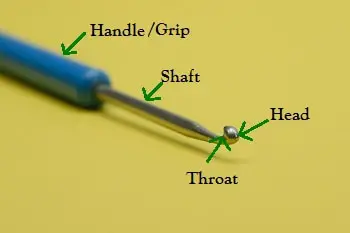
Handle/Grip
Regular crochet hooks have a pencil like handle. It is thin and cylindrical. Many have a flat section for the thumb rest. Ergonomic hooks have built up handles that are supposed to be formed to your hand to decrease the potential of wrist/hand pain.
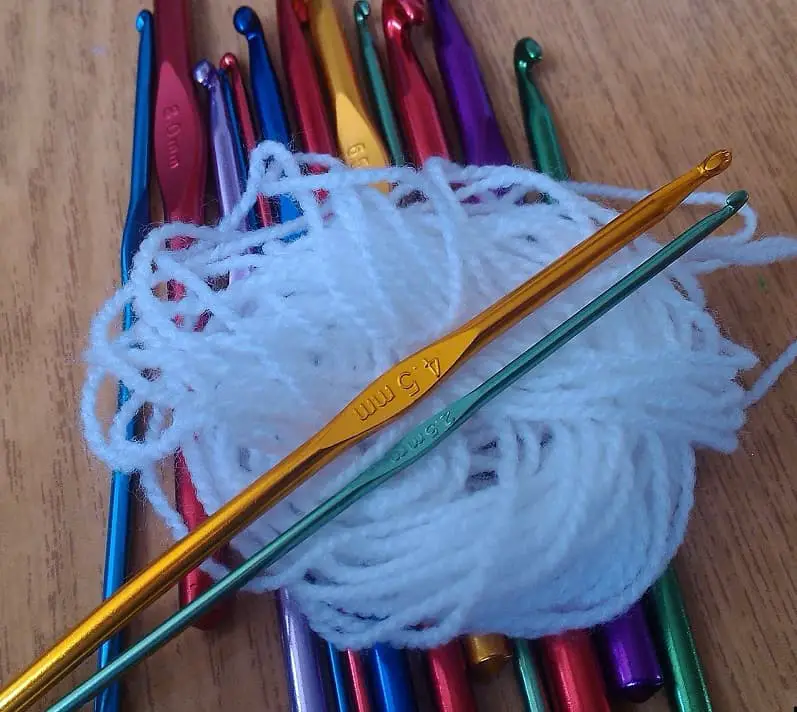
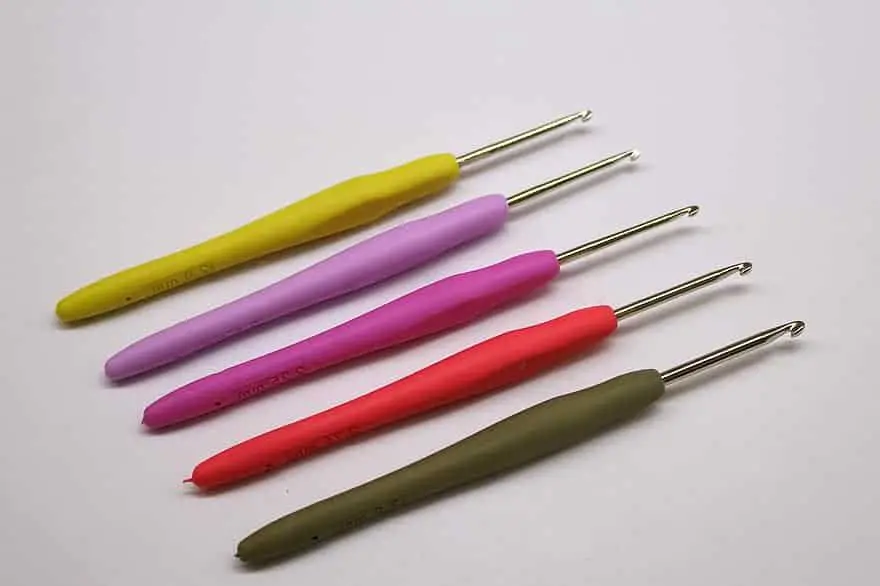
Shaft
The shaft is the section between the thumb rest (if present) and the throat. The diameter of the shaft determines the size the crochet hook, which will ultimately determine the size of your stitches.
Throat
The throat is the actual “hook” part of the hook. It is the part that catches the yarn. It can be “inline” which means that the shaft and the head are the same diameter, or it can be tapered which means that the head is actually a larger diameter than the shaft and sticks out in farther forward. The result is that the throat of an inline hook is deeper than that of a tapered hook.
The deeper the throat, the less likely the yarn is to slip off the hook. This also means that it is a bit “harder” to slip the yarn off the hook, though. This being said, it is easier to control the yarn with an inline hook, but typically faster to crochet with a tapered hook.
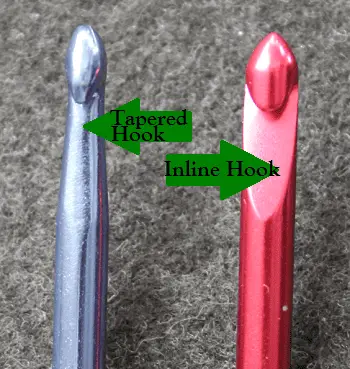
Another difference is that an inline hook can make it a little bit easier to keep a looser tension because of the wider throat. Tapered hooks can lead to pulling the stitch too tight making it harder to maintain a consistent tension.
Again, it really comes down to personal preference on which is better; most people like the one they happened to start with the best because they got used to it. I usually use tapered hooks, but neither is right or wrong.
Head
The head is the tip of the hook. It can be more pointy or more rounded. More pointy makes inserting the hook easier in terms of precision, but it also makes it more likely to split the yarn between the “plies” (individual threads that are wound together to make the yarn). Which is better is purely personal preference.
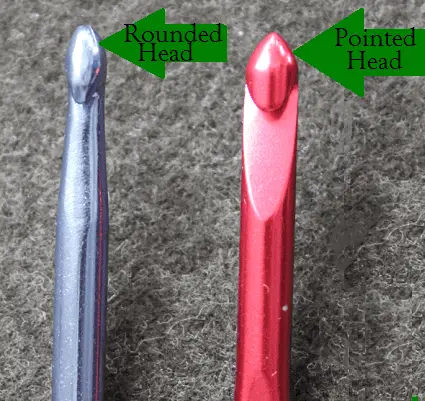
Crochet Hook Material
Crochet hooks can be made of many different materials. Most common is metal, usually aluminum. Other materials that can be used are plastic, bamboo, wood, acrylic, or even glass. Each material has its own benefit, and as you progress with crochet, you may want to venture out into various materials.
I recommend to begin with aluminum hooks, but let’s look at the features of each type of hook.
Aluminum
The main benefits of aluminum are that it is smooth and light weight. The yarn will glide smoothly over the hook and not catch or have excessive friction. It is not the most lightweight material, but it is light enough that it will not cause too much hand fatigue. This makes it a very good material for beginner to start with.
Aluminum hooks can be made fully of aluminum, or the handle can be built up with rubber, plastic, clay, etc to give it a thicker ergonomic handle. This variety also makes it nice for beginners.
Plastic
Plastic hooks are are actually another good option for beginners, though not as durable as aluminum hooks. These hooks are inexpensive and come in all sizes. They are also very lightweight making them pretty comfortable to work with. Generally, they are also smooth and glide smoothly through the yarn, though they are not quite as smooth as aluminum hooks.
Note that for larger hook sizes, many are made of plastic versus metal because the thick sizes are too heavy when made of metal.
Bamboo
Bamboo hooks are inexpensive and common. They are very lightweight and typically have thicker handles which will limit hand/wrist fatigue. They are also warm to the touch, versus metal hooks that can be cold which some people don’t like. They also are not at smooth as metal, which make them less slippery to hold. Yarn will also not slip around on the hook as much as with metal hooks which can result in better control, but can also be frustrating if you have trouble getting the yarn off the hook.
Wood
Wood hooks have pretty much the same benefits of as bamboo hooks, but they are more expensive. They are actually more expensive that most kinds of hooks, so they are not great for beginners for that reason.
Acrylic
Acrylic hooks are light and comfortable to work with. They can be inexpensive, or they can cost more if they are more decorative. The main drawback to acrylic hooks is that they can break easily, so they do not last as long as other hooks.
Glass
Glass hooks are not very common. They are very smooth and glide easily through the yarn. They can also be custom made to fit your hand which can reduce risk for injury. This being said, they are heavier than other hooks, and can cause more strain that way, so there is a give and take. They are fairly durable but not as durable as metal or wood hooks, and if they do break, it is glass, so it can cause injury. They are also more expensive than other hooks.
Crochet Hook Purchase Recommendation
As already stated, I recommend starting with aluminum crochet hooks. I also recommend beginning with regular hooks (versus ergonomic hooks) unless you already have wrist/hand pain (such as from arthritis or carpel tunnel syndrome). They are much less expensive, but can still be high quality if you choose the correct brands. If you do have a history of wrist/hand pain, you may want to invest in hooks with ergonomic handles. These are more expensive, but will help to reduce the risk of pain with your new hobby.
Side note: If you start with regular hooks and develop some pain, you may just need to take more breaks and build up the time you spend crocheting more slowly. You don’t necessarily need to jump straight to ergonomic handles.
When purchasing hooks, you can purchase a single hook in the size that you want, but I recommend purchasing this six pack of aluminum hooks from Amazon, Susan Bates Silvalume Crochet Hooks. These hooks are high quality and have a smooth finish that will not snag your yarn. They are inexpensive, and by having the whole pack you can make many different projects as you learn. Also, purchasing each hook individually will result in a higher cost overall because a single hook will cost around $5 and the pack of six only costs around $10.
If you do plan to go straight to ergonomic hooks, I recommend Clover Amour Crochet Hooks. These are very high quality and will last a long time making them a good investment. But, they are somewhat pricey, so you may want to purchase a single hook to make sure that it is comfortable and works for you before you invest in the whole pack. You can purchase just the size I (5.5 mm) Clover Amour Hook at Amazon.
Beginner Crochet Patterns (Size I Hook)
Now that you know about crochet hooks, it is time to test them out!
Below I have linked to various crochet patterns that use a Size I/9 (5.5 mm) crochet hook. (Which is, again, the hook I recommend for beginners.) All of these patterns are rated beginner/easy. The list is broken down into the following categories:
- Washcloths
- Blankets
- Scarves
- Hats
- Accessories
- Miscelaneous
If you need help learning to read a crochet pattern before diving into any of these, check out How Do You Actually Read a Crochet Pattern. This is an in depth post about interpreting each part of the pattern!
Washcloth Patterns
Plain & Simple Dish Cloth/Wash Cloth
by Laurie Laliberte
JustRight and BigTime Dishcloths
by Deborah Ellis
Simple Crocheted Dish Cloth
by Grace Hood
Ribbed Single Crochet Dishcloth
by Amy Ramnarine
Blanket Patterns
Purely Square Baby Throw
by Lion Brand Yarn
Simple Rectangular Granny Blanket
by Marie Segares
Crochet Super Easy Baby Blanket
by Purl Soho
Stadium Blanket
by Herrschners
Perfect Beginner Afghan
by Bobbi Anderson

JustRight and BigTime Dishcloths
by Deborah Ellis
Scarf Patterns
One Ball Scarf
by Arabia Temple
Harry Potter POA Crochet Scarf
by Andres P. Nevarez
Ocean Net Infinity Scarf
by Undeniable Glitter- Alyssa
Hat Patterns
Worsted Weight Basic Beanie
by Diane Serviss
Basic Beanie
by Melissa Hassler
Preemie Hat
by Kara Gunza
Spring Sparkle Slouch Hat
by KerryLane Crochet – Kerry Sutton
Accessory Patterns
Hyperbolic Velvet Scrunchies
by Tamara Kelly
Third Loop Headband
by Cassie Stebelton
Crochet Knotted Headband
by Britt Walker
Super Simple Bow Headband
by Dorianna Rivelli
Chain Necklace
by Maria Isabel
Scalloped Boot Cuffs
by Danyel Pink
Miscellaneous Patterns
Cotton Bib
by Tiffany Roan
Easy Boho Coasters
by Grace Forthefrills
Home All Day Slipper Socks
by Fiber Flux / Jennifer Dickerson
Coraline’s Endless Summer Tunic
by Celina Lane
I hope you enjoyed learning about crochet hooks and looking through the patterns! If you think of any other questions about about crochet hooks, drop me a comment, and I will answer the best I can!
Now it is time for YOU to get Crafty with Ashy! Pick a pattern and show me your results in the comments! I would love to see them!
Be sure to subscribe and follow me so you don’t miss any inspiration!
